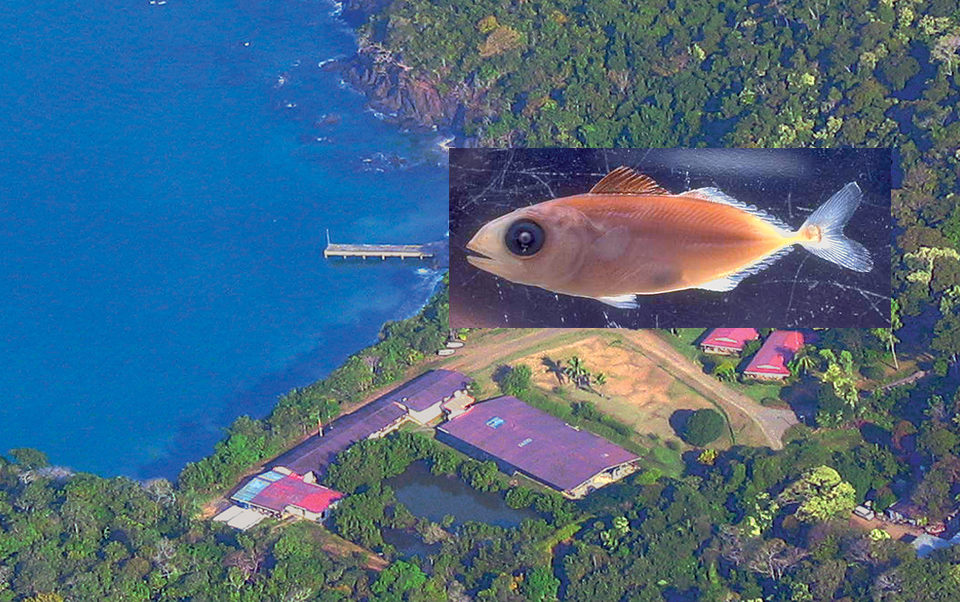Work focuses on broodstock nutrition and resulting egg quality, larval and juvenile nutrition

The Achotines Laboratory is located on the Pacific coast of Panama. Photo by Liam Scholey.At the Inter-American Tropical Tuna Commission’s Achotines Laboratory in southern Panama, research centers on tuna biology, particularly the early life history of yellowfin tuna (Thunnus albacares). From 2001 to 2003, four laboratory trials were conducted to examine the effects of probiotics (beneficial Gram-positive bacteria) on the survival of yellowfin tuna larvae during the first week of feeding.
The trials were carried out by Patrick Tracy, a graduate student at the University of Miami’s Rosenstiel School of Marine and Atmospheric Science (RSMAS); Dr. Daniel Benetti, director of the RSMAS Aquaculture Program; and the authors.
Probiotic studies

Yellowfin larvae are routinely reared at the Achotines Laboratory on a first-feeding diet of cultured and enriched rotifers. However, rotifer cultures are characterized by an abundant and complex bacterial flora. It was anticipated that the occurrence of pathogenic, Gram-negative bacteria could be reduced when the rotiers and larvae were treated with probiotics to enhance rotifer production and promote better larval survival.
The experimental trials lasted for seven or eight days of feeding. Yellowfin larvae were stocked in replicated tanks. Probiotic treatments involved the addition of probiotic bacteria at stocking, first feeding and daily intervals thereafter. In control tanks, untreated larvae were fed only enriched, but untreated, rotifers.
Mixed results
Results of the trials were mixed. Two experiments in 2001 and 2002 indicated that probiotics appeared to slightly improve survival of the larvae. A third trial in 2003 showed no difference in survival between probiotic treatment and controls.
Results from the fourth experiment in 2003 indicated the average survival of larvae treated with probiotics was four times that of the control fish. However, the results were highly variable and therefore not statistically significant. One additional trial is planned for 2005.
Weaning diet trials
Yellowfin are routinely reared up to six weeks after hatching for a variety of experimental purposes at the Achotines Laboratory. Rearing protocols in past studies have involved feeding a sequence of live planktonic foods, fish larvae, and minced fish to late larvae and early juveniles.
During 2004, early-juvenile yellowfin were reared on a diet of fish larvae and several types of artificial pellet feed. The majority of the juveniles survived 36 days after hatching, and a small group survived longer than 45 days. The longest-lived individual was 65 days old at death, at which time it was approximately 6 cm in standard length.
These fish were the first juvenile yellowfin reared partially on an artificial diet at the Achotines Laboratory. Further rearing trials of early-juvenile yellowfin using artificial diets are planned.
Other research
The authors are continuing research on yellowfin tuna at the Achotines Laboratory to study broodstock nutrition and resulting egg quality, larval and juvenile nutrition and the development of vision in tuna. The main emphasis of the research is ecological experimentation, but the basic biological information gained will also have practical applications for the mariculture of tunas and other pelagic species.
(Editor’s Note: This article was originally published in the April 2005 print edition of the Global Aquaculture Advocate.)
Now that you've finished reading the article ...
… we hope you’ll consider supporting our mission to document the evolution of the global aquaculture industry and share our vast network of contributors’ expansive knowledge every week.
By becoming a Global Seafood Alliance member, you’re ensuring that all of the pre-competitive work we do through member benefits, resources and events can continue. Individual membership costs just $50 a year. GSA individual and corporate members receive complimentary access to a series of GOAL virtual events beginning in April. Join now.
Not a GSA member? Join us.
Authors
-
Daniel Margulies, Ph.D.
Inter-American Tropical Tuna Commission
8604 La Jolla Shores Drive
La Jolla, California 92037 USA -
Vernon Scholey, M.S.
Inter-American Tropical Tuna Commission
8604 La Jolla Shores Drive
La Jolla, California 92037 USA -
Sharon Hunt, M.S.
Inter-American Tropical Tuna Commission
8604 La Jolla Shores Drive
La Jolla, California 92037 USA -
Jeanne Wexler, B.S.
Inter-American Tropical Tuna Commission
8604 La Jolla Shores Drive
La Jolla, California 92037 USA -
Vernon Scholey, M.S.
Inter-American Tropical Tuna Commission
Achotines Laboratory
Las Tablas, Los Santos Province, Panama
Tagged With
Related Posts

Health & Welfare
Achotines laboratory home to continuing studies of tuna early life history
The Inter-American Tropical Tuna Commission Achotines Laboratory in southern Panama is the world’s only facility with nearly year-round availability of tuna eggs and larvae. A study is comparing the reproductive biology, genetics and early life history of yellowfin and Pacific bluefin tuna.

Intelligence
Aquaculture key to increasing seafood supplies to Arab states
Arab States have substantial natural resources to increase aquaculture production. Several types of systems are readily adaptable and can be implemented relatively quickly.

Intelligence
Byproduct utilization for increased profitability, part 1
Protease enzymes are important industrial enzymes that have diverse applications in food, leather, silk and the agrichemical and pharmaceutical industries. Fish are considered one of the richest sources of proteolytic enzymes.

Intelligence
Byproduct utilization for increased profitability, part 4
Protein hydrolysates can be produced by acid, base or enzymatic hydrolysis processes. Acid hydrolysis produces salt that makes the product unsuitable for food and destroys some essential amino acids. An optimum process for one fish or shellfish by-product may not be optimum for another.


